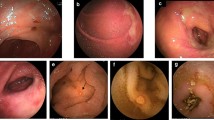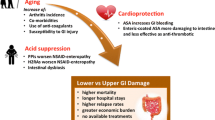Summary
Nonsteroidal anti-inflammatory drugs (NSAIDs) are one of the most commonly used and therapeutically effective groups of drugs in the Western world. However, gastrointestinal problems constitute all too frequently reported unwanted effects of NSAIDs; their effects on the gastric (and intestinal) mucosaare, therefore, well documented.
A review of the evidence suggests that NSAID-induced gastric damage occurs as a result of a dual insult, by NSAID-mediated direct (and indirect) acidic damage followed almost simultaneously by the deleterious (systemic) effect of prostaglandin inhibition.
A number of strategies have been used in the management of NSAID-induced gastric damage; however, not all have been entirely successful. Nonetheless, a number of approaches have met with a considerable amount of success, including direct gastroprotection, enhancement of mucosal defence mechanisms and, perhaps most encouragingly, the development of newer NSAIDs which display not only considerable clinical efficacy but a reduced gastrointestinal adverse event profile.
Similar content being viewed by others
References
Allen A. Structure of gastrointestinal mucus glycoproteins and the viscous and gel-forming properties of mucus. British Medical Bulletin 34: 28–33, 1978
Allen A, Pain RH, Robson TR. Model for the structure of the gastric mucous gel. Nature 264: 88–89, 1976
Armstrong CP, Blower AL. Non-steroidal anti-inflammatory drugs and life threatening complications of peptic ulceration. Gut 28: 527–532,1987
Bjarnason I, Macpherson A. The changing gastrointestinal side effect profile of non-steroidal anti-inflammatory drugs. Scandinavian Journal of Gastroenterology 24 (Suppl. 163): 56–64, 1989
Blackburn WD, Alarcon GS. Misoprostol in treatment of gastropathy due to nonsteroidal anti-inflammatory drugs. American Journal of Medicine 88: 85, 1990
Bowen BK, Krause WJ, Ivey KJ. Effect of sodium bicarbonate on aspirin-induced damage and potential difference changes in human gastric mucosa. British Medical Journal 2: 1052–1055, 1977
Brune K, Graf P, Rainsford KD. A pharmacokinetic approach to the understanding of therapeutic effects and side effects of salicylates. Agents and Actions (Suppl. 1): 9-26, 1977a
Brune K, Nürnberg B, Szelenyi I, Vergin H. the enterohepatic circulation of some anti-inflammatory drugs may cause intestinal ulcers. In Rainsford KD & Velo GP (Eds) Side-effects of anti-inflammatory drugs, pp. 29–39, MTP Press Ltd, Lancaster, 1986
Brune K, Scheitzer A, Eckert H. Parietal cells of the stomach trap salicylates during absorption. Biochemical Pharmacology 26: 1735–1740, 1977b
Cheung LY. Gastric mucosal blood flow: its measurement and importance in mucosal defence mechanisms. Journal of Surgical Research 36: 282–288, 1984
Chvasta TA, Cooke AR. The effect of several ulcerogenic drugs on the canine gastric mucosal barrier. Journal of Laboratory and Clinical Medicine 79: 302–315, 1972
Cooke AR. The role of the mucosal barrier in drug-induced gastric ulceration and erosions. Digestive Diseases and Sciences 21: 155–164, 1976
Crampton JR, Gibbons LC, Rees WDW. Effect of luminal pH on the output of bicarbonate and PGE2 by the normal human stomach. Gut 28: 1291–1295, 1987
Davenport HW. Damage to the gastric mucosa: effects of salicylates and stimulation. Gastroenterology 49: 189–196, 1965
DeSchepper PJ, Tjandramaga TB De R00. Gastrointestinal blood loss after diflunisal and after aspirin: effect of ethanol. Clinical Pharmacology and Therapeutics 23: 669–676, 1978
Domschke S, Domschke W. Clinics in gastroenterology: peptic ulcer disease. In Boucheir et al. (Eds) Gastro-duodenal damage due to drugs, alcohol and smoking, Vol. 13, pp. 405–436, WB Saunders, London, 1984
Flemström G. Intracellular accumulation and permeability effects of some weak acids in the isolated frog gastric mucosa. Acta Physiologica Scandinavica 82: 1–16, 1971
Giercksky K-E, Huseby G, Rugstad H-E. Epidemiology of NSAID-related gastrointestinal side effects. Scandinavian Journal of Gastroenterology 24 (Suppl. 163): 3–8, 1989
Graham DY. Prevention of gastroduodenal injury induced by chronic nonsteroidal antiinflammatory drug therapy. Gastroenterology 96: 675–681, 1989
Grossmann MI, Matsumoto KK, Lichter RJ. Fecal blood loss produced by oral and intravenous administration of various salicylates. Gastroenterology 40: 383-388, 161
Guth PH. Gastric mucosal blood flow and resistance to injury. In Holtermüller KH & Malagelada J-R (Eds) Advances in ulcer disease. International Congress Series 537, pp. 101–109, Excerpta Medica, Amsterdam, 1980
Hawkey CJ. Non-steroidal anti-inflammatory drugs and the gastric mucosa: mechanisms of damage and protection. Alimentary Pharmacology and Therapeutics 25: 57–64, 1988
Hersey DF, Weisman MH. Minutes of the 19th meeting FDA Arthritis Advisory Committee, pp. 1-22, Food and Drug Administration, Washington DC, 1988
Hills BA, Butler BD, Lichtenberger LM. Gastric mucosal barrier: hydrophobic lining to the lumen of the stomach. American Journal of Physiology 244: 567–568, 1983
Ivey KJ. Drugs, gastritis and peptic ulcer. Clinical Gastroenterology 3 (Suppl. 2): 29-34, 1981
Jabbari M, Valberg LS. Role of acid secretion in aspirin-induced gastric mucosal injury. Journal of the Canadian Medical Association 102: 178–181, 1970
Langman MJS, Morgan L, Worrall A. Use of anti-inflammatory drugs by patients admitted with small or large bowel perforations and haemorrhage. British Medical Journal 290: 347–349, 1985
Lichtenberger LM, Richards JE, Hills BA. Effect of 16,16-dimethyl prostaglandin E2 on the surface hydrophobicity of aspirin-treated canine gastric mucosa. Gastroenterology 88: 308–314, 1985
Ligumsky M, Golonska EM, Hansen DG, Kauffman GL. Aspirin can inhibit gastric mucosal cyclo-oxygenase without causing lesions. Gastroenterology 84: 756–761, 1983
McCormack K, Brune K. Classical absorption theory and the development of gastric mucosal damage associated with the nonsteroidal anti-inflammatory drugs. Archives of Toxicology 60: 261–269, 1987
MacKercher PA, Ivey KJ, Baskin WM, Krause WJ. Protective effect of cimetidine on aspirin induced gastric mucosal damage. Annals of Internal Medicine 87: 676–679, 1977
Main IHM, Whittle BJR. Investigation of the vasodilator and antisecretory role of prostaglandins in the rat gastric mucosa by use of non-steroidal anti-inflammatory drugs. British Journal of Pharmacology 53: 217–224, 1975
Manniche C, Malchow-Moller A, Andersen JR, Pedersen C, Hansen TM. Randomised study of the influence of non-steroidal anti-inflammatory drugs on the treatment of peptic ulcer in patients with rheumatic disease. Gut 28: 226–229, 1987
Martin BK. Accumulation of drug anions in gastric mucosal cells. Nature 198: 896–897, 1963
Murray HS, Strottman MP, Cooke AR. Effect of several drugs on gastric potential difference in man. British Medical Journal 1: 19–21, 1974
O’Laughlin JC, Hoftiezer JW, Ivey KJ. Effect of aspirin on the human stomach in normals: endoscopic comparison of damage produced one hour, 24 hours and 2 weeks after administration. Scandinavian Journal of Gastroenterology 16 (Suppl. 67): 211, 1981
Piotrowski J, Gabryeleqicz A, Konturek S, Kwiecien N, Rydzewska G. Ranitidine effect on gastric mucosa damage in patients with rheumatoid diseases on long-term treatment with non-steroidal anti-inflammatory drugs. Materia Medica Prologue 3: 170–176, 1986
Rainsford KD. Gastric mucosal ulceration induced by tablets but not suspensions of solutions of aspirin in pigs. Journal of Pharmacy and Pharmacology 30: 129–131, 1978
Rainsford KD. Aspirin and salicylates, Butterworths, London, 1984
Rainsford KD. Mechanisms of gastric contrasted with intestinal damage by non-steroidal anti-inflammatory drugs. In Rainsford KD & Velo GP (Eds) Side-effects of anti-inflammatory drugs, pp. 3–28, MTP Press Ltd, Lancaster, 1986
Rainsford KD. Gastric ulcerogenicity of non-steroidal antiinflammatory drugs in mice with mucosa sensitized by cholinomimetic treatment. Journal of Pharmacy and Pharmacology 39: 669–672, 1987
Rainsford KD. Mechanisms of gastrointestinal damage by nonsteroidal anti-inflammatory drugs. In Ulcer disease: new aspects of pathogenesis and pharmacology, CRC Press, Boca Raton, 1988
Rainsford KD. Mechanisms of gastrointestinal toxicity of nonsteroidal anti-inflammatory drugs. Scandinavian Journal of Gastroenterology 24 (Suppl. 163): 9–16, 1989
Rainsford KD, Willis C. Relationship of gastric mucosal damage induced in pigs by antiinflammatory drugs to their effects on prostaglandin production. Digestive Diseases and Sciences 27: 624–635, 1982
Redfern JS, Lee E, Feldman M. Effect of indomethacin on gastric mucosal prostaglandins in humans: correlation with mucosal damage. Gastroenterology 92: 969–977, 1987
Rees WDW. Mucus-bicarbonate barrier — shield or sieve? Gut 28: 1553–1556, 1987
Ross IN, Habib M, Bahari M, Turnberg LA. The pH gradient across mucus adherent to rat fundic mucosa in vivo and the effect of potential damaging agents. Gastroenterology 81: 731–738, 1981
Roth SH. Nonsteroidal anti-inflammatory drug gastropathy. Archives of Internal Medicine 146: 1075–1076, 1986
Schoen RT, Vender RJ. Mechanisms of nonsteroidal anti-inflammatory drug-induced gastric damage. American Journal of Medicine 86: 449–458, 1989
Semble EL, Wu WC. Anti-inflammatory drugs and gastric mucosal damage. Seminars in Arthritis and Rheumatism 16: 271–286, 1987
Shen TY. Indomethacin, sulindac and their analogues. In Rainsford (Ed.) Anti-inflammatory and antirheumatic drugs, Vol. 1, pp. 149–159, CRC Press, Boca Raton, 1985
Silvestrini B. Benzydamine, a unique model of anti-inflammatory activity. International Journal of Tissue Reactions 9: 87–91, 1987
Somerville K, Faulkner G, Langman M. Non-steroidal anti-inflammatory drugs and bleeding peptic ulcer. Lancet 1: 462–464, 1986
Szabo S, Brown A. Prevention of ethanol-induced vascular injury and gastric mucosal lesions by sucralfate and its components: possible role of endogenous sulfhydryls. Proceedings of the Society for Experimental Biology and Medicine 185: 493–497, 1987
Szabo S, Spill WF, Rainsford KD. Non-steroidal anti-inflammatory drug-induced gastropathy. Mechanisms and management. Medical Toxicology and Adverse Drug Experience 4: 77–94, 1989
Szabo S, Spill WF, Rainsford KD. Non-steroidal anti-inflammatory drug-induced gastropathy: mechanisms and management. Medical Toxicology and Adverse Drug Experience 4: 77–94, 1989
Vener KJ, Moore JG, Szabo S. Chronobiology and ulcerogenesis. Chronobiology International 4: 1–2, 1987
Welch RW, Bentch LH, Harris SC. Reduction of aspirin induced gastrointestinal bleeding with cimetidine. Gastroenterology 74: 459–463, 1978
Zoli G, Pasquinelli G, Bonvicini F, Gasbarrini G, Laschi R. SEM Study II: protective effect of ranitidine against gastric and duodenal lesions induced by non-steroidal anti-inflammatory drugs. International Journal of Tissue Reactions 8: 71–77, 1986
Author information
Authors and Affiliations
Rights and permissions
About this article
Cite this article
Price, A.H., Fletcher, M. Mechanisms of NSAID-Induced Gastroenteropathy. Med Toxicol Adverse Drug Exp 40 (Suppl 5), 1–11 (1990). https://doi.org/10.2165/00003495-199000405-00003
Published:
Issue Date:
DOI: https://doi.org/10.2165/00003495-199000405-00003




